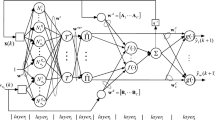Abstract
This paper provides a comparative study of several non-linear blind equalizers in terms of computational requirements and of the transient performance, which is the main criterion to be considered in the context of time-varying channels. Computational requirements are estimated as the number of real additions and multiplications associated with the training algorithm, whereas the transient performance is evaluated in terms of convergence time. The impact of local minima on the tracking ability is carefully evaluated, in terms of a suitable criterion proposed in the paper. Simulations involve both single-layer (linear and polynomial filters), as well as multilayer structures (radial basis function, recurrent network, multilayer perceptron). These techniques are applied to the blind equalization of mobile terrestrial and satellite channels. Guidelines are established for the choice of a suitable structure as the major trade-off to be achieved in a mobile context is between computational effort and robustness of tracking capability (with respect to local minima effects).
Similar content being viewed by others
References
Babich F, Lombardi G. A Markov model for the mobile propagation channel. IEEE Trans. Veh. Tech. 2000;49(1):63–73.
Bic J-C, Charbonnier A, Duponteil D, Ruelle N, Tabbane S, Taisant JP. Radiocommunications and mobility. Ann. Télécommun 1995;50(1):114–141.
Benedetto S, Biglieri E. Non-linear equalization of digital satellite channels. IEEE J. Selected Areas in Communications 1983;SAC-1:57–62.
Bouchired S, Ibnkahla M, Roviras D, Castanié F. Equalization of satellite mobile communication channels using combined self-organizing maps and RBF networks. In: Proc. of ICASSP’98. Seattle, USA, 1998.
Bouchired S, et al. Equalization of satellite UMTS channels using neural network devices. In: Proc. of ICASSP’99. Phoenix, USA, 1999.
Bouchired S, Roviras D, Castanié F. Equalisation of satellite mobile channels with neural network techniques. Space Communications 1998/1999;15:209–220.
Callender CP, Cowan CFN. A comparison of six different non-linear equalisation techniques for digital communications systems. In: Proc. of EUSIPCO’94. Edinburgh, UK, 1994:1524–1527.
Chinrungrueng C, Séquin CH. Optimal adaptive K-means algorithm with dynamic adjustement of learning rate. IEEE Trans. Neural Net. 1995;6(1):157–169.
Chen S, Mulgrew B, Grant PM. A clustering technique for digital communication channel equalization using radial basis function networks. IEEE Trans. Neural Net. 1993:4(4):570–579.
Chen S, McLaughlin S, Mulgrew B. Complex-valued radial basis function network, part II: Application to digital communications channel equalisation. Signal Processing 1994;36:175–188.
Cowan CFN, Semnani S. Time-variant equalization using a novel non-linear adaptive structure. Int. J. Adapt. Control Signal Process. 1998;12:195–206.
Davis LM, Collins IB, Evans RJ. Identification of time-varying linear channels. In: Proc. of ICASSP’97. Munich, Germany, 1997:3921–3924.
Destro Filho JB, Romano JMT. Influence of parameter initialization on the performance of nonlinear blind equalizers for satellite communications. In: Proc. of IEEE/EUROCON’2001, Bratislava, Slovakia, 2001:5–7.
Destro Filho JB, Favier G, Romano JMT. Neural networks for blind equalization. In: Proc. of GLOBECOM’96. London, UK, 1996:196–200.
Destro Filho JB, Favier G, Romano JMT, Dycke B. A comparison of two neural solutions for blind equalization. In: Proc. of IEEE/CESA’98, IMACS Multicoference, Nabeul-Hammamet, Tunisia, April; 1998:4:548–553.
Destro Filho JB, Favier G, Romano JMT. On a new multilayer blind equalizer. In: GLOBECOM’99, Rio de Janeiro, Dec. 1999.
Duel-Hallen A, Hu S, Hallen H. Long-range prediction of fading signlas. In: IEEE Sig. Proc. Magazine May 2000:62–75.
Gan Q et al. A complex valued radial basis function network for equalization of fast time varying channels. IEEE Trans. on Neural Net. 1999;10(4):958–960.
Gan Q, Saratchandran P, et. al. A complex valued radial basis function network for equalization of fast time varying channels. IEEE Trans. Neural Net. 1999;10(4):958–960.
Georgoulakis K, Theodoridis S. Blind and semi-blind equalization using hidden Markov models and clustering techniques. Signal Processing 2000;80:1795–1805.
Giannakis GB, Tepedelenlioglu C. Basis expansion models and diversity techniques for blind identification and equalization of time-varying channels. Proc. of the IEEE 1998;86(10):1969–1986.
Goka T, Matsumoto H, Nemoto N. SEE flight data from Japanesesatellites. IEEE Trans. on Nuclear Science 1998;45(6):2771–2778.
Godard DN. Self-recovering equalization and carrier tracking in two-dimensional data communication systems. IEEE Trans. on Commun. 1980;COM-28(11):1867–1875.
Haykin S (ed.) Unsupervised Adaptive Filtering. USA: John Wiley and Sons Inc., vols: 1–2; 2000.
Hilal K, Duhamel P. A general form for recursive adaptive algorithms leading to an exact recursive CMA. In: Proc. ICASSP’92, vol. IV, San Francisco, March 1992:17–20.
Kechriotis G, Zervas E, Manolakos ES. Using recurrent neural networks for adaptive communication channel equalization. IEEE Trans. on Neural Net. 1994;5(2):267–278.
Lee J, Beach C, Tepedelenlioglu N. A practical radial basis function equalizer. IEEE Trans. Neural Net. 1999;10(2):450–455.
Matolak DW. On the multi-state modelling of mobile satellite channels. In: Proc. of MILCOM’2000, Session 8, October 2000.
Sato Y. A Method of self-recovering equalization for multilevel amplitude-modulation systems. IEEE Trans. Commun., 1975;COM-23:679–682.
Tsatsanis MK, Giannakis GB, Zhou G. Estimation and equalization of fading/channels with random coefficients. Signal Processing 1996;53:211–229.
Xiang Z, Bi G, Le-Ngoc T. Polynomial perceptrons and their applications to fading channel equalization and co-channel interference suppression. IEEE Trans. Sig. Proc. 1994;42(9):2470–2480.
Yates RD, Mandayam NM. Low-cost wireless data transmission. IEEE Signal Proc. Magazine, May 2000.
You C, Hong D. Nonlinear blind equalization schemes using the complex-valued multilayer feedforward neural networks. IEEE Trans. on Neural Net. 1998;9(6):1442–1455.
Ziegler RA, Cioffi JM. Estimation of time-varying digital radio channels. IEEE Trans. Veh. Tech. 1992;41(2):134–151.
Author information
Authors and Affiliations
Corresponding author
Rights and permissions
About this article
Cite this article
Destro-Filho, JB. Performance Comparison of Several Non-Linear Equalizers in the Context of Mobile Telecommunications. Inf Syst Front 7, 113–128 (2005). https://doi.org/10.1007/s10796-005-1473-4
Issue Date:
DOI: https://doi.org/10.1007/s10796-005-1473-4




